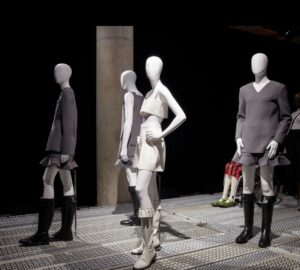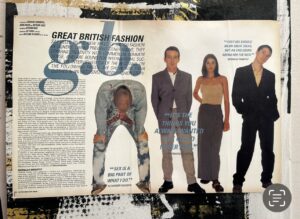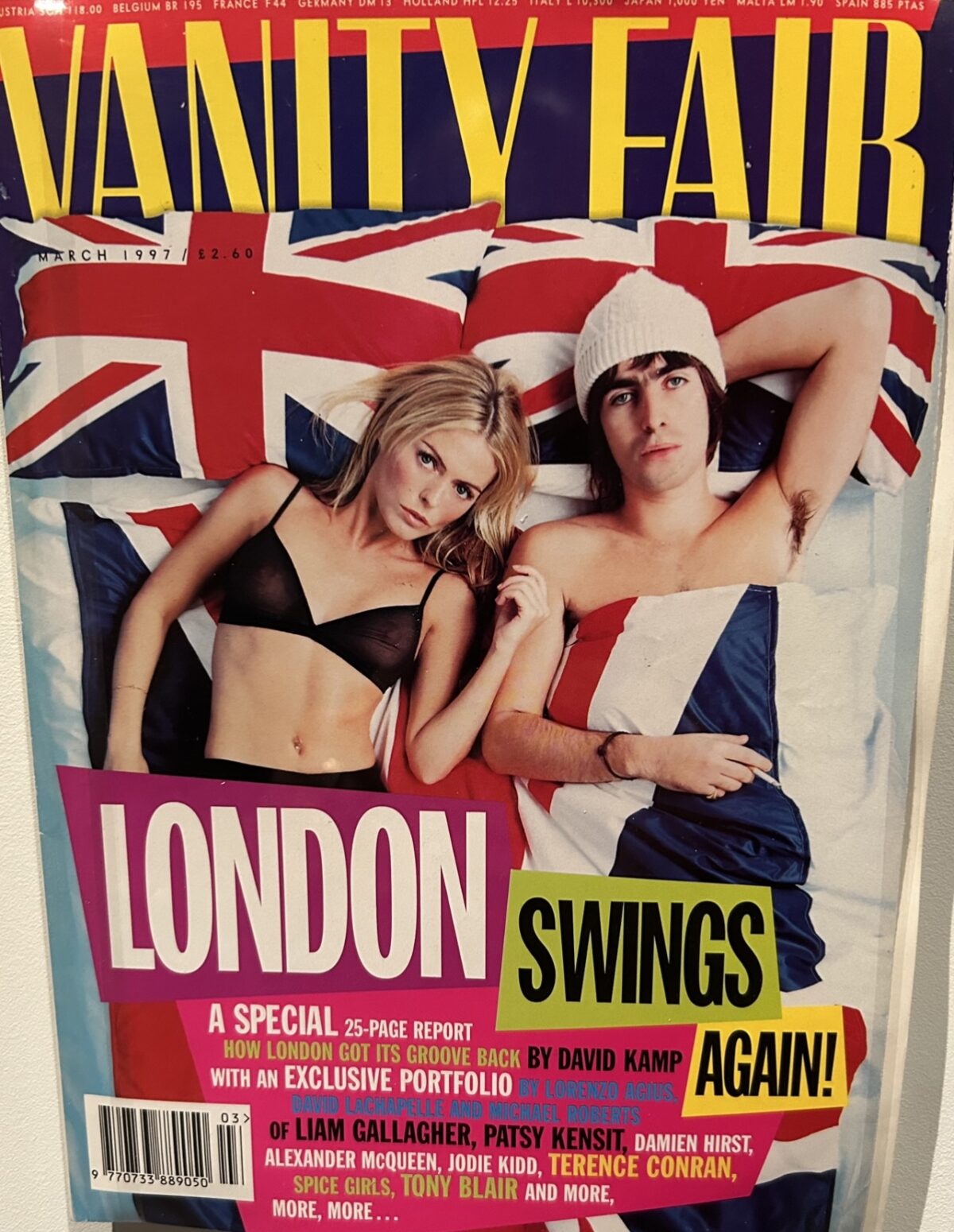
Londoners have always cared about how they look. Throughout history, each generation has created its own looks, with inspiration drawn from a wide variety of sources. Rebel is a new exhibition at London’s Design Museum. It focuses on the early work of a group of about 300 fashion designers from the past thirty years, specifically, those designers who were part of the New Generation (New Gen) group of Fashion Designers, supported in part by the British Fashion Council at the beginning of their careers.
 The exhibition showcases about 100 outfits from this group, designed when most of them were in their twenties. The outfits are grouped into places, influences and experiences unique to London, including London’s amazing fashion colleges and nightclubs. Looks are shown alongside press clippings, memorabilia, video footage etc. to take us on a nostalgic journey through a particularly exciting period in its fashion history.
The exhibition showcases about 100 outfits from this group, designed when most of them were in their twenties. The outfits are grouped into places, influences and experiences unique to London, including London’s amazing fashion colleges and nightclubs. Looks are shown alongside press clippings, memorabilia, video footage etc. to take us on a nostalgic journey through a particularly exciting period in its fashion history.
 Thirty years ago, in 1993, London was slowly emerging from a rather brutal five-year recession – the hangover of the excess of the 1980’s. I actually started working in the fashion industry that year. Business was tough but that meant rents were low. This, combined with a thriving YBA (Young British Artist) art scene, a particularly hedonistic queer club scene, a healthy music industry, new style magazines such as Dazed & Confused, and a fertile crop of fashion graduates from top London fashion colleges such as Central St Martins and the Royal College of Art, meant that creative London was on a roll. The foundations of what was to become known as Cool Britannia in the mid-nineties had been laid, and London’s fashion industry in the 90s finally came to be seen as a respectable alternative to the fashion capitals of Milan, Paris and New York.
Thirty years ago, in 1993, London was slowly emerging from a rather brutal five-year recession – the hangover of the excess of the 1980’s. I actually started working in the fashion industry that year. Business was tough but that meant rents were low. This, combined with a thriving YBA (Young British Artist) art scene, a particularly hedonistic queer club scene, a healthy music industry, new style magazines such as Dazed & Confused, and a fertile crop of fashion graduates from top London fashion colleges such as Central St Martins and the Royal College of Art, meant that creative London was on a roll. The foundations of what was to become known as Cool Britannia in the mid-nineties had been laid, and London’s fashion industry in the 90s finally came to be seen as a respectable alternative to the fashion capitals of Milan, Paris and New York.
 The roll-call of designers featured in the exhibition is impressive. It doesn’t matter whether or not their businesses survived. There can be no doubt as to the level of creativity generated by the capital’s young designers over the past few decades. The inspiring group of designers includes Alexander McQueen, Copperwheat Blundell, Antonio Berardi, Clements Ribeiro, Julian McDonald, Sophia Kokosalaki, Kim Jones, Gareth Pugh, Marjan Pejoki, Jonathan Saunders, Sibling, Mary Katrantzou, JW Anderson, Grace Wales Bonner, Christopher Kane, Nasir Mazhar, Craig Green, Michael Halpern, Molly Goddard, Harri and many more. They are spread across various sections, including an ‘Art School’ section which details the influence of the great London fashion colleges on their work. The ‘Club Scene’ rooms reference the influence of various different genres of club nights, queer and straight, on different designers’ work. There is a ‘Runway’ section featuring different designer’s work both backstage and front-of-house, as well as a timeline of the past thirty years highlighting the launch of the different fashion labels against a backdrop of what was happening culturally and news-wise in London.
The roll-call of designers featured in the exhibition is impressive. It doesn’t matter whether or not their businesses survived. There can be no doubt as to the level of creativity generated by the capital’s young designers over the past few decades. The inspiring group of designers includes Alexander McQueen, Copperwheat Blundell, Antonio Berardi, Clements Ribeiro, Julian McDonald, Sophia Kokosalaki, Kim Jones, Gareth Pugh, Marjan Pejoki, Jonathan Saunders, Sibling, Mary Katrantzou, JW Anderson, Grace Wales Bonner, Christopher Kane, Nasir Mazhar, Craig Green, Michael Halpern, Molly Goddard, Harri and many more. They are spread across various sections, including an ‘Art School’ section which details the influence of the great London fashion colleges on their work. The ‘Club Scene’ rooms reference the influence of various different genres of club nights, queer and straight, on different designers’ work. There is a ‘Runway’ section featuring different designer’s work both backstage and front-of-house, as well as a timeline of the past thirty years highlighting the launch of the different fashion labels against a backdrop of what was happening culturally and news-wise in London.
 To curate thirty years of London’s young fashion designers’ work and their inspiration into one exhibition was always an ambitious aim. The range of the designers’ work exhibited is interesting, and British humour and eccentricity is well represented, although I feel presenting fashion on static mannequins is never as exciting as seeing the outfit moving on a video or in real life. Video and mannequins combined together for many of the looks would have been more energetic. The other area in which the exhibition falls short is that choosing to only focus on fashion colleges and clubland as inspiration for London fashion designers’ work ignores the myriad of other influences in London that shape their work, namely London’s art and music scenes, stylists, photographers, models, fashion editors and PRs, magazine editorial, current events, street style, muses, hair and make-up trends, other designers, pattern cutters, history and so on. The sources of inspiration are endless. The exhibition title of ‘Rebel’ is also a little misleading as all these fashion designers ultimately conform to the fashion industry’s systems, rules, deadlines and standards. There are actually no rebels in the fashion industry. Having said that, London has a super-important role in global fashion trends and I hope that this exhibition will help inspire the next generation of fashion designers to be brave and make their mark on the world.
To curate thirty years of London’s young fashion designers’ work and their inspiration into one exhibition was always an ambitious aim. The range of the designers’ work exhibited is interesting, and British humour and eccentricity is well represented, although I feel presenting fashion on static mannequins is never as exciting as seeing the outfit moving on a video or in real life. Video and mannequins combined together for many of the looks would have been more energetic. The other area in which the exhibition falls short is that choosing to only focus on fashion colleges and clubland as inspiration for London fashion designers’ work ignores the myriad of other influences in London that shape their work, namely London’s art and music scenes, stylists, photographers, models, fashion editors and PRs, magazine editorial, current events, street style, muses, hair and make-up trends, other designers, pattern cutters, history and so on. The sources of inspiration are endless. The exhibition title of ‘Rebel’ is also a little misleading as all these fashion designers ultimately conform to the fashion industry’s systems, rules, deadlines and standards. There are actually no rebels in the fashion industry. Having said that, London has a super-important role in global fashion trends and I hope that this exhibition will help inspire the next generation of fashion designers to be brave and make their mark on the world.
REBEL: 30 Years of London Fashion The Design Museum, London 16 SEPTEMBER 2023 – 11 FEBRUARY 2024 Sponsored by Alexander McQueen.

Queerguru’s Contributing Editor Ris Fatah is a successful fashion/luxury business consultant (when he can be bothered) who divides and wastes his time between London and Ibiza. He is a lover of all things queer, feminist, and human rights in general. @ris.fatah

